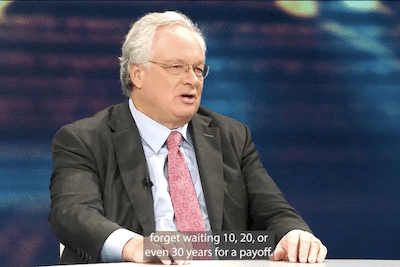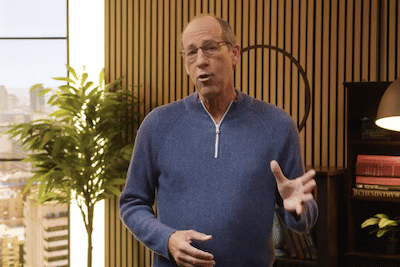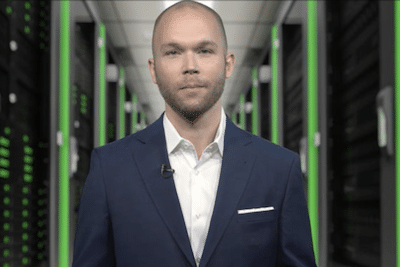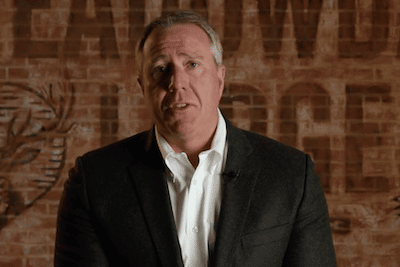Today I’m looking into a presentation by Whitney Tilson about “America’s Next Big Monopoly,” a company he claims will change everything about the way we live and disrupt countless industries thanks to a new technology called the “Quaternary Code.”
According to the presentation, Whitney Tilson’s past discoveries have “monopolized their industries and soared as much as 20,000%.”
And apparently, he’s now sharing the “biggest story of 2022,” a “new potential monopoly” that he predicts could hand investors gains of 1,000% or more in the years ahead.
What stock is he teasing?
Tilson reveals one stock in the presentation for free, CRISPR Therapeutics. But he doesn’t share his “America’s Next Big Monopoly” (AKA Quaternary Code) stock pick. The only way to access that is to join his advisory service, Empire Stock Investor, for $49.
However, I did some digging to find out what stock he’s teasing. And in this post, I’ll show you everything I found, including the name and ticker symbol of his top pick. I’ll also discuss a third stock he teases which he dubs “California’s Longest-Running Monopoly.”
But first, let’s unpack Tilson’s “quaternary code” prediction…
What Is the Quaternary Code? (Unpacking Whitney Tilson’s Prediction)
Whitney Tilson began the “Next Big Monopoly” presentation by stating that the secret to financial success is “getting in early on a future monopoly and compounding the gains.”
What does he mean by “monopoly?”
Whitney Tilson isn’t talking about the type of monopolies that are barred by the U.S. Instead, he’s referring to companies that dominate their industries.
“Now of course, we aren’t talking about an actual monopoly barred by the U.S. government – we are simply talking about companies that dominate their respective industries.”
In the presentation, Whitney Tilson says he believes he’s found the next big monopoly and that it could set investors up for 1,000% gains. He also says it’s “as close as you are going to get” to investing in companies like Amazon, Apple, or Google in the early days.
“The million-dollar question is: How can you spot the next big monopoly?
I believe I’ve found it… I’ll bet anything you’ve never heard of it. And I predict folks who get into this investment now could be setting themselves up for long-term gains of well over 1,000% in the years to come.”
[…]
“From what I’ve seen of it so far… This is as close as you are going to get to investing in Amazon in 1999… Apple in 2000… or Google in 2004. In fact, this company just went public in recent months, but is already one of the most dominant forces in its space.”
Why is he so bullish on this one company?
In short, his prediction centers around the “quaternary code.”
What the heck is that?
Until now, I’d never heard of such a “code,” and I’m pretty sure Tilson made it up as part of the presentation. I say this because what he’s (actually) talking about when he uses the term “quaternary code” appears to be genomic sequencing in the context of synthetic biology.
Let me explain…
During the presentation, Whitney Tilson shows a picture of a desk with a bunch of electronic devices (phone, laptop, camera, etc.) on it and a plant in the corner.
And he says that “the most powerful piece of technology” on the desk is actually the plant because instead of using binary code (a string of 1s and 0s) like computers, it uses the quaternary code, which he also refers to as “biology code.”
“You see, all the gadgets in this photo use binary coding… but the plant uses a much more advanced code which I refer to as the Quaternary Code.”
[…]
“In the same way, the plant is like a computer. But instead of using computer code, it uses nature’s code, or biology code, or the code of life…
This code is more advanced and more precise than the binary code.
The main difference between the two codes is that while the computer code uses 0s and 1s (again, binary code), this code uses four symbols – A, T, C, and G.
That’s why I call it ‘Quaternary Code.'”
As you can see, he also mentions the letters A, T, C, and G.
A quick Google search reveals that ACGT is an acronym for the four types of bases found in a DNA molecule. So, when Whitney Tilson says “Quaternary Code,” he’s referring to DNA.
He also says that the quaternary code is a “manufacturing code.”
“In a nutshell… The quaternary code is a manufacturing code.”
According to Whitney Tilson, scientists have learned how to program the quaternary code and make all sorts of products, from vaccines and tires to cement and data storage.
“But vaccines are just the tip of the iceberg…
The quaternary code is already being used to manufacture other products like tires, meats, medicinal marijuana, wood, leather, perfumes, plastic, cement, and even data storage devices.”
Whitney Tilson says that this code is “going to completely change the game for manufacturers” and reveals that it all has to do with synthetic biology.
“What binary code is to the software industry, the quaternary code is to a rapidly developing industry called ‘synthetic biology.'”
What is synthetic biology?
Synthetic biology is a branch of science that involves biotechnology, genetic engineering, DNA sequencing, genomics, and many other disciplines.
And from what I understand, its purpose is essentially to create new products and improve existing ones based on what already exists in nature.
It’s a complex but fascinating subject, and I encourage you to research it further as it’s something that has many, many different applications.
Whitney Tilson does a great job of breaking it all down in the presentation, too. I don’t think I’ve (ever) suggested my readers check out the transcript of a presentation I’ve covered on this site, but this may be the exception.
Because, marketing fluff aside, he shares numerous examples of how synthetic biology is making products better, cheaper, and more abundant while also increasing manufacturing speed. In particular, he talked about how it would disrupt four main industries: the pharmaceutical industry, technology, agriculture, and plastics.
He’s not the only “guru” talking about this technology either.
In fact, what he discussed was very similar to Joel Litman’s SynBio prediction, which I recently wrote about. Many of the examples Tilson used about how synthetic biology works in the presentation reminded me of what Litman talked about in his teaser.
For example, both Tilson and Litman shared examples of how innovations like DNA-based data storage and self-healing concrete are being made possible with synthetic biology. And they both talked about how it’s disrupting the agriculture and textile industries.
What’s more, it appears they are both pitching the same stock!
What Is Whitney Tilson’s “America’s Next Big Monopoly” Stock Pick?
Whitney Tilson shared three stock picks during the presentation.
His first pick is CRISPR Therapeutics (ticker: CRSP). According to Tilson, this company is “focused on the development and future commercialization of gene editing.” And he recommends buying shares up to a price of $120.
“I think CRISPR is now ready for its next growth phase. That’s why my team and I rate CRISPR (CRSP) shares a ‘buy’ up to $120.”
However, that’s not Whitney Tilson’s “next big monopoly” stock pick.
“But as bullish as we are on CRISPR, if you’re looking to 5X or even 10X your money… then you’ll want to invest in the company I believe will be America’s next big monopoly.”
To figure out what stock this could be, let’s look at the clues he shares:
“The business model of ‘America’s next big monopoly’ is to synthesize the code (raw material) that goes into various products and then license it to other companies, which make the actual products.”
[…]
“This business model is very much like Amazon Web Services, or Apple’s App Store.
But instead of supplying custom software solutions (Amazon Web Services) and applications (Apple Inc.), they supply custom genomes in the form of code.
These unique genomes are being produced in a massive 219,000-square-foot laboratory in a regular-looking office building in Boston.”
What could it be? I believe Whitney Tilson’s “Quaternary Code” (AKA “America’s Next Big Monopoly”) stock pick is Ginkgo Bioworks (ticker: DNA).
Why? Because firstly, the clues Tilson shared reminded me of Joel Litman’s teaser that I only just wrote about, and his pick was also Ginkgo Bioworks.
So, that’s what initially tipped me off that it could be this company.
And as I started digging through the other clues Whitney Tilson shared, it became clear that this is definitely his “America’s Next Big Monopoly” pick.
Here’s a summary of why:
- Ginkgo Bioworks is a Boston-based biotech company that is building a platform that enables customers to program cells as easily as programming a computer. And according to the company website, its mission is to “make biology easier to engineer.” I’m not an expert on synthetic biology, but the company seems to fit Tilson’s description well.
- Tilson says that “America’s next big monopoly” signed a $100 million deal with Bayer and a $122 million deal with Cronos. And both of these clues match Ginkgo.
- He also stated that Cathie Wood invested almost $90 million in the company, and Bill Gates invested $275 million, which both check out.
- And Tilson states that his recommended company has acquired over 400 million proprietary gene sequences, which is also a match with Ginkgo Bioworks.
So, Ginkgo Bioworks is undoubtedly the “America’s Next Big Monopoly” (AKA “quaternary code”) company Whitney Tilson teases in the presentation.
How do you find out for sure?
Tilson reveals his pick in the “America’s Next Big Monopoly” research report, which comes as a bonus for joining his advisory service, Empire Stock Investor.
But before I get to that… there’s actually a third stock Whitney Tilson mentions in the presentation that he refers to as “California’s Longest-Running Monopoly.” And he says he sees “potential gains of as much as 500% in the coming years” with this stock.
What company is he talking about?
According to Tilson, it’s a California-based company that software firms depend on and that he claims has partnered with Tesla.
“In fact, the company has partnered with Tesla to set up a project that is the largest of its kind in the world.”
He provides numerous other clues, but the one that led me to it was a quote from the CEO he shared, which led me right to PG&E Corporation (ticker: PCG).
From there, I looked into the other clues Tilson shared about the company, and it seemed to line up. In short, PG&E is a utility company based in California, and it matches what Tilson said about Californians depending on it and how it has an “understanding with the state of California.” It also seems to match the clue about Tesla.
According to insideevs.com, Pacific Gas & Electric (PG&E) is undergoing a battery energy storage project with Tesla that consists of 256 Tesla Megapacks in California.
So, it looks like Tilsons’s third pick is PG&E.
In any case, he details his pick in a report called “California’s Longest-Running Monopoly – How to Potentially 5X Your Money.” And like the last report, it comes with a subscription to Empire Stock Investor. So let’s look at what this service is about.
Recommended: Go here to see my #1 rated stock advisory of 2024
What Is Empire Stock Investor?
Empire Stock Investor is a stock advisory service run by Whitney Tilson of Empire Financial Research. The service costs $49 if you join through the presentation and gives you access to Whitney Tilson’s latest stock picks and research.
In particular, the service focuses on helping subscribers profit from emerging trends and primarily shares investment ideas involving large-cap U.S. stocks.
Each month, Tilson shares his latest investment idea, his research on the company, and updates you on any changes to the model portfolio (positions he’s already recommended). He also sends subscribers an email each day the markets are open to keep you in the loop.
Aside from that, you get the research reports I mentioned earlier.
The first one is called “America’s Next Big Monopoly” and covers his “quaternary code” pick. And the second one is the “California’s Longest-Running Monopoly” report which details the company we just discussed.
How well has the service performed?
According to Whitney Tilson, it beat the S&P 500 in 2020:
“In 2020, the average annualized gain of all our stock recommendations was 54.8%, nearly twice the returns of the S&P 500 index over the same period. This return measures the results achieved by all of our recommendations in 2020, scaled to a one-year period.”
I’m not sure how well it did in 2021. And either way, that doesn’t mean you’ll make money with it going forward. But Empire Stock Investor is a legitimate service, and it seems to have a strong track record from what I can see.
How much does it cost?
An Empire Stock Investor subscription costs between $49 to $129, depending on which membership option you select. And it renews at $199 after the first 12 months regardless of which option you choose.
Is Whitney Tilson the Real Deal?
Whitney Tilson is a former hedge fund manager with over 20 years of experience on Wall Street. Today, he runs Empire Financial Research, a New York-based financial publishing company he launched in 2019.
Tilson’s flagship advisory is Empire Stock Investor, but he also runs a higher-tier service called Empire Investment Report. And the company sells numerous other services run by other investment experts, including Enrique Abeyta.
Aside from being a hedge fund manager and stockpicker, Tilson’s work has been featured on many popular financial media outlets, and he has authored numerous finance-related books.
As far as his stock picks, aside from the ones I’ve discussed in this post, I’ve written about two other presentations he’s released and uncovered some of his picks in each.
One presentation centered around his “Connexa Terra” metaverse stock picks, and the other was about his Netstake prediction, where he teased his top sports gambling stock.
So, if you want to see what other stocks he’s bullish on, check those out.
In any case, to answer the question: yes, Whitney Tilson is a genuine investment expert. There’s no guarantee his stock picks will make you money, but he is legit, and from what I can tell, he has picked numerous winning stocks over the years.
Bottom Line
Whitney Tilson’s “America’s Next Big Monopoly” presentation is all about how the “quaternary code” is being used to create all kinds of new products.
As I mentioned earlier, the term “quaternary code” relates to DNA sequencing in the context of synthetic biology. And synthetic biology involves scientists using nature to make (or re-create) “stuff” to make it better, cheaper, and more abundant.
All in all, Tilson shares three stock picks in the presentation.
The first one he gives away for free (CRISPR Therapeutics), the second one is Ginkgo Bioworks, and the third company appears to be PG&E.
Of course, those last two are guesses, but they match Tilson’s clues, so I’m confident I’m on the money there.
If you want Tilson’s research on each of his picks, you’ll need to sign up for Empire Stock Investor for $49. And it looks like a great service, from what I can tell.
What do I think about Tilson’s prediction?
I think synthetic biology is an incredible field with enormous potential; I can’t wait to see how some of these innovations unfold in the years ahead.
I have no idea how well any of the stocks will do because I’m not a stockpicker, nor do I have a crystal ball, but the technology the first two companies work on is really cool. So I’m excited to see what the future holds for this tech and companies like Ginkgo.
In any case, that’s it from me. I hope you enjoyed the post and found it helpful. And if you want to share your thoughts on any of this, chime in below.












Please note: By submitting a comment using the above comment form, you confirm that you agree with the storage and handling of your data by this site as detailed in our Privacy Policy.